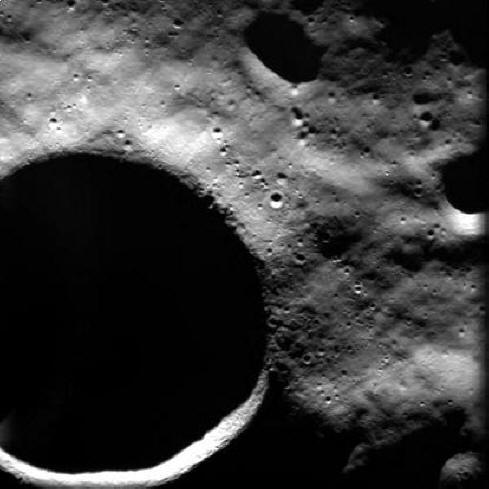
home •
about •
essential guide •
picture of the day •
thunderblogs •
news •
multimedia •
predictions •
products •
get involved •
contact
picture of the day archive subject index
Shackleton crater near the south lunar pole. Credit: AMIE/ESA Smart-1 Orbiter.
Nov 07, 2008
The Barren Moon Born Out
The Japanese SELENE mission has confirmed the Moon is a desert wasteland.A renewed interest in lunar colonization was motivated by the Clementine spacecraft after it entered orbit around the Moon in January 1994. When the mission data was analyzed, scientists announced that the south pole of the Moon contained pockets of water ice shielded from the Sun inside deep craters and covered by insulating rocks and dust. NASA launched the Deep Space Program Science Experiment satellite (Clementine) because the abundant water could be a source of hydrogen.
Although NASA lost the spacecraft due a thruster malfunction, it was able to perform a substantial portion of its mission to map the surface of the Moon. When Clementine supposedly detected water ice in Shackleton crater at the south pole on the Moon, it was thought that establishing a Moon base had taken one step closer to becoming a reality.
The goal of a manned lunar base has been held in abeyance since the sixties because of cost and scaling problems. In order to provide life support for even a small group of astronauts the space vehicle would have to be enormous. Carrying the oxygen, food and water necessary, not to mention a habitat with sufficient psychological stimulation for an extended stay on the Moon, is beyond our current technology. Launching the payloads into space would mean a project too costly to contemplate even if it were technically feasible.
Water ice can be split into oxygen and hydrogen, so solar panels could used to create breathable air, potable water and fuel to power the machinery. Also, areas of the south pole not far from some permanently shadowed craters are mountainous regions in permanent sunlight, known as "peaks of eternal sunshine," so a continuous energy source would be available provided the base were built on the mountaintops.
Lunar regolith contains compounds that would enable astronauts to make the fuel for a return journey, so it was hoped that an extensive cost saving could be realized because no fuel except that required to reach the Moon need be carried onboard. A much smaller booster would also mean larger crew quarters and more science experiments. However, a team of researchers questioned the accuracy of Clementine’s data. The instruments might have detected reflections off the steep crater walls and not ice deposits. Since the radar signature came from both brightly illuminated and darkly shaded areas of Shackleton crater, it probably bounced off rocks and other debris rather than ice.
Now, the Japanese spacecraft Kaguya finds that the south pole craters contain no ice after all. On September 14, 2007, the Japan Aerospace Exploration Agency (JAXA) launched the Selenological and Engineering Explorer (SELENE) on a multiyear lunar orbit mission. Otherwise known as Kaguya, a nickname from Japanese folktales, the SELENE spacecraft is designed to provide data for future landing sites and to analyze the surface. Upon lunar orbit insertion, Kaguya released two sub-satellites, Okina and Ouna. One of the remotes will act as a relay for the main equatorial imaging system and the other as an additional radar platform in polar orbit.
The floor of Shackleton crater was measured at –183° Celsius, but the Terrain Camera, with a 10 meter resolution, showed no bright, highly reflective patches. The researchers noted that the small excess of hydrogen ions recorded by instruments on previous missions was most likely implanted in the regolith by the solar wind.
As we have written in past Picture of the Day articles, the search for water on the Moon is most likely a forlorn hope. The Moon does not present features caused by innumerable strikes from high-velocity space rocks or thousands of comets out of a hypothetical Oort Cloud. Lunar structures and terrain are the result of powerful electric discharges at some time in the relatively recent past.
The morphology of the Moon – and the south pole in particular – shows the signs of electric discharge machining as we have argued many times. No water-bearing impactors formed the terrain there. Rather, it was electricity that carved the Moon, and any water that might have once existed was obliterated by the energy released in the events.
By Stephen Smith
___________________________________________________________________________Please visit our Forum
The Electric Sky and The Electric Universe available now!

|
|

|
EXECUTIVE EDITORS:
David Talbott, Wallace Thornhill
MANAGING EDITORS:
Steve Smith, Mel Acheson
CONTRIBUTING EDITORS: Michael Armstrong, Dwardu Cardona,
Ev Cochrane,
C.J. Ransom, Don Scott, Rens van der Sluijs, Ian Tresman
WEBMASTER: Brian Talbott
Copyright 2008: thunderbolts.info
![]()
home •
thunderblogs •
forum •
picture of the day •
resources •
team •
updates •
contact us

